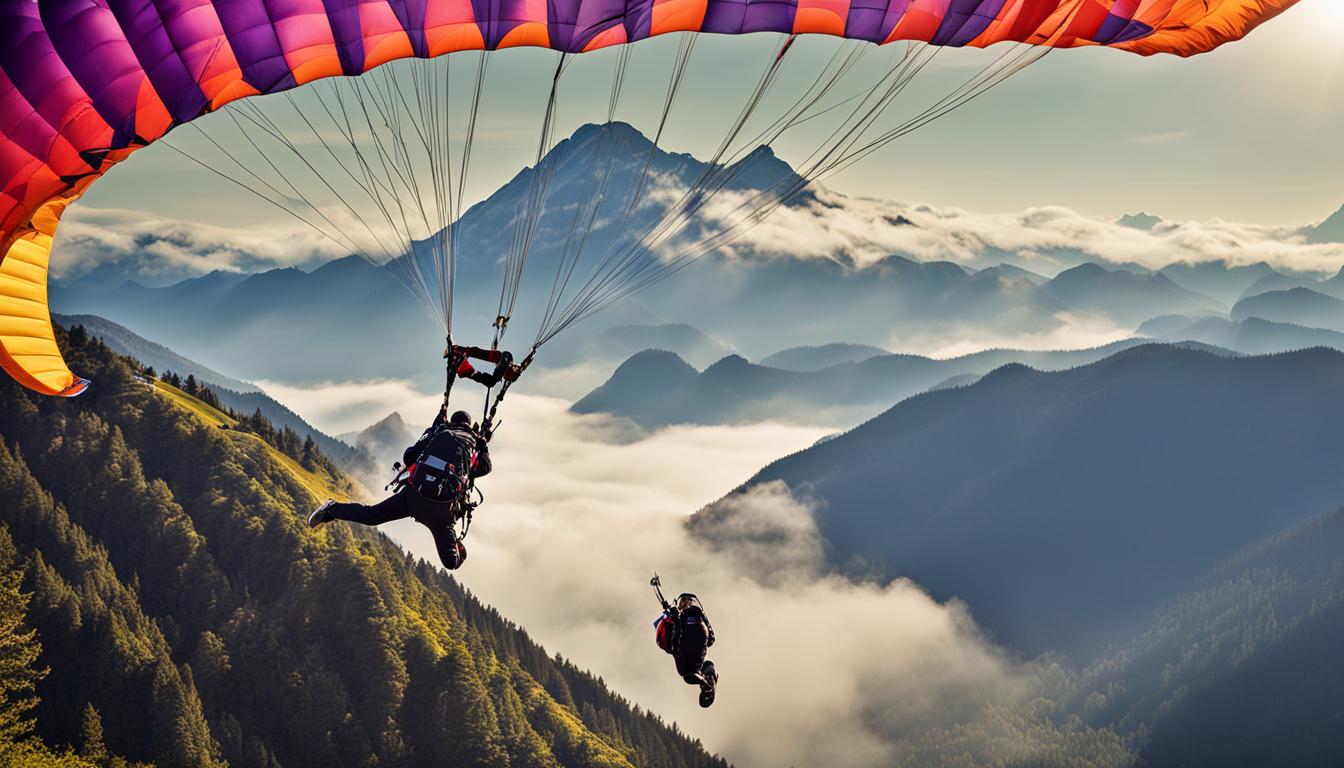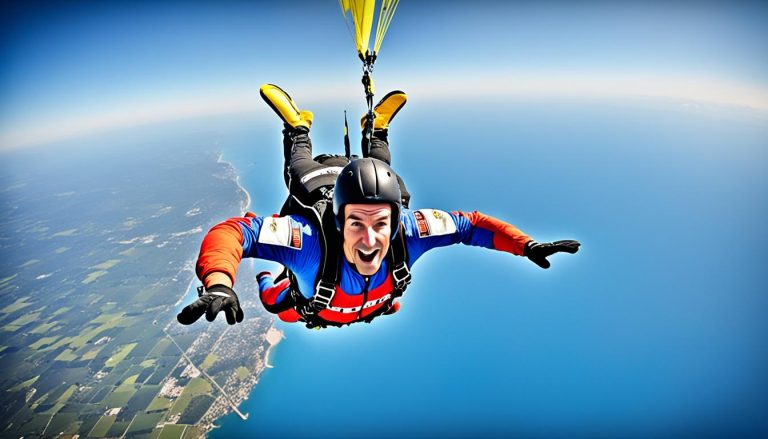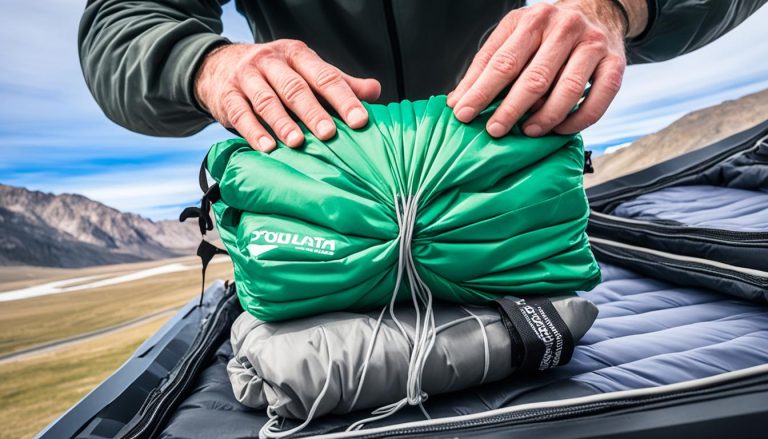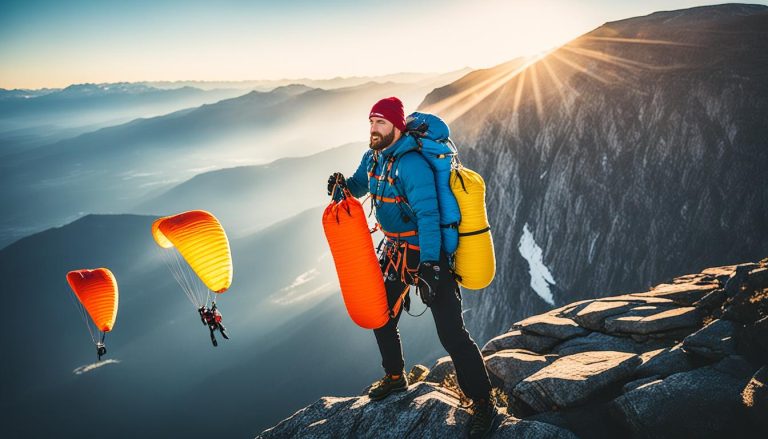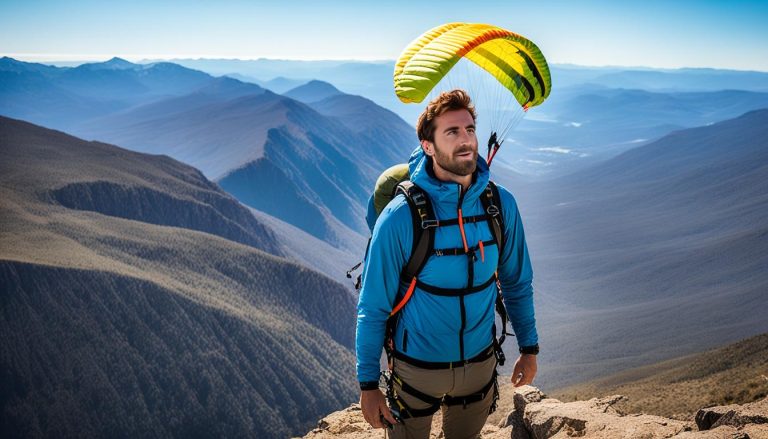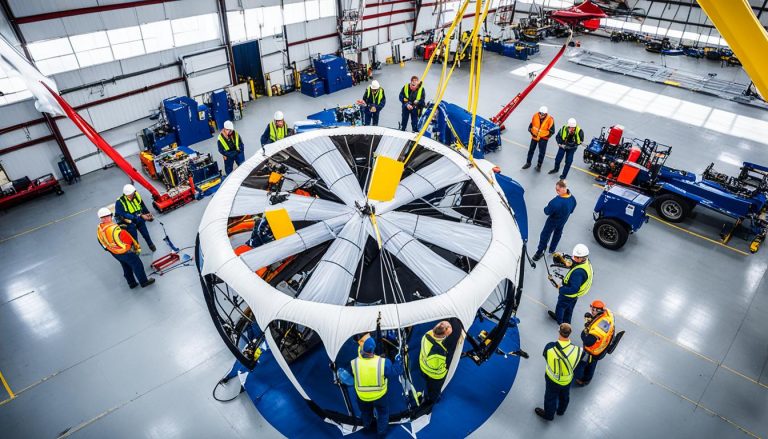Understanding the type of parachute used for skydiving from high mountains
When it comes to mountain skydiving, the type of parachute used plays a crucial role in ensuring a safe and thrilling experience. High-altitude skydiving from mountains requires specialized gear designed to withstand the unique challenges posed by extreme altitudes. From high altitude skydiving equipment to mountain skydiving gear, understanding the different types of parachutes used for skydiving from high mountains is essential.
In high-altitude military parachuting, the techniques of High-Altitude Low Opening (HALO) and High-Altitude High Opening (HAHO) are employed. HALO involves opening the parachute at a low altitude after free-falling for a period of time. HAHO, on the other hand, involves opening the parachute at a high altitude just seconds after jumping from the aircraft. These techniques have not only been adapted for military purposes but also for non-military skydiving adventures.
HALO/HAHO jumps typically take place at altitudes ranging from 15,000 to 35,000 feet, with skydivers reaching speeds of up to 126 mph. The high altitude and increased speed necessitate specialized gear and equipment to ensure the safety and success of the jumps.
In the upcoming sections, we will delve into the details of HALO and HAHO techniques, the training and qualifications required for high-altitude military operations, health risks, safety considerations, and the specific gear needed for HALO jumps. Whether you are an adventure seeker or have a fascination with the extraordinary, understanding the type of parachute used for skydiving from high mountains is a must for an unforgettable experience.
High-Altitude Low Opening (HALO)
The HALO technique, originally developed for military use in the 1960s, has now found its place in the world of non-military skydiving. HALO jumps involve opening the parachute at a low altitude after a thrilling period of free-fall. This technique is primarily utilized for delivering equipment, supplies, or personnel in military operations, requiring altitudes ranging from 15,000 to 35,000 feet.
HALO jumps offer several advantages, both in terms of safety and stealth. By opening the parachute at a low altitude, parachutists can minimize their exposure to flak in active anti-aircraft areas. Additionally, HALO jumps allow for stealthy insertions due to the combination of high downward speed and minimal forward airspeed.
“HALO jumps provide the perfect combination of excitement and precision, making them a valuable tool in military operations.”
High-altitude military parachuting, such as HALO, requires meticulous training and precise execution. Parachutists must be skilled in handling both the physical demands and technical aspects of the jumps. Furthermore, the use of specialized gear and equipment, including the HALO parachute itself, is crucial in ensuring a safe and successful jump.
In summary, HALO jumps not only offer a thrilling experience for skydiving enthusiasts but also serve as a vital technique for military operations. The combination of the HALO parachute, high-altitude military parachuting, and the HALO technique itself creates a unique and exhilarating adventure in the sky.
Advantages of HALO Jumps:
| Advantages | Description |
|---|---|
| Stealthy Insertions | The high downward speed and minimal forward airspeed of HALO jumps allow for covert insertions in military operations. |
| Reduced Exposure | Opening the parachute at a low altitude minimizes the parachutist’s exposure to flak in active anti-aircraft areas. |
| Extended Freefall | HALO jumps provide longer freefall times, offering skydivers an unmatched experience. |
| Effective Delivery | The HALO technique is widely utilized for delivering equipment, supplies, or personnel in military operations. |
High-Altitude High Opening (HAHO)
The HAHO technique is a crucial aspect of high-altitude military parachuting. It is employed when aircraft cannot safely fly above enemy skies without risking detection and creating a threat. HAHO jumps enable the covert insertion of military personnel into enemy territory by allowing them to airdrop from high altitudes.
In a typical HAHO exercise, jumpers deploy their parachutes immediately after exiting the aircraft at high altitudes. From there, they rely on waypoints and terrain features to navigate and reach their designated landing areas. This technique allows for longer travel distances, with jumps extending over 40 miles.
To maintain the operation’s covert nature, HAHO jumps are often performed at night. This strategic choice ensures that the military personnel can execute their missions without raising unnecessary attention. The darkness and the precision of HAHO jumps enhance the element of surprise and increase the chances of mission success.
HAHO jumps require a high level of skill, training, and precision. Military personnel undergo extensive training to master the HAHO technique and execute these jumps safely and effectively. The navigation skills and situational awareness necessary for successful HAHO jumps make them an essential aspect of high-altitude military operations.
Military Free-Fall (MFF)
Military personnel participating in high-altitude military operations undergo intense training and certification to prepare for the challenges of military free-fall. This demanding skill is considered one of the most dangerous in special operations due to its high-risk nature. Operations are typically conducted under cover of darkness to maintain stealth and conceal the presence of the operators from opposing forces.
The journey towards military free-fall certification begins with completing the static-line certification, which involves deploying the parachute automatically upon exiting the aircraft. Once this foundation is established, individuals progress to the military free-fall course.
The military free-fall course focuses on developing advanced skills required for high-altitude jumps. This includes mastering techniques to stabilize the body in flight, ensuring control and precision during free-fall. Additionally, trainees learn how to effectively use the necessary oxygen equipment to counter the effects of altitude.
Specialized training programs equip military personnel with the physical and mental capabilities needed to successfully perform military free-fall operations. The training encompasses intensive physical conditioning, mental fortitude development, and comprehensive instruction on safety procedures and emergency protocols.
| Training Component | Description |
|---|---|
| Physical Conditioning | Endurance training, strength training, and aerobic exercises to enhance overall fitness and stamina. |
| Mental Preparedness | Training to enhance mental resilience, situational awareness, and decision-making skills in high-pressure environments. |
| Safety Protocols | Instruction on emergency procedures, equipment checks, risk assessment, and communication protocols necessary for safe operations. |
| Emergency Response | Training to handle potential emergencies during free-fall, such as parachute malfunctions or entanglements. |
Successfully completing the military free-fall training and certification ensures that operators possess the necessary skills and qualifications for performing high-altitude military operations. The rigorous training and extensive preparation undertaken by military personnel reflect the meticulousness and commitment required to execute these missions safely and effectively.
Health Risks and Safety Considerations
High-altitude jumps, including HALO and HAHO, pose unique health risks and require specific safety precautions to ensure a safe experience. Understanding these risks and taking necessary precautions is crucial for the well-being of skydivers.
Hypoxia: Low Oxygen Levels
One of the primary health risks associated with high-altitude jumps is hypoxia, which occurs due to low oxygen levels at high altitudes. Hypoxia can lead to symptoms such as dizziness, confusion, and loss of consciousness, posing a significant danger to skydivers.
To mitigate the risk of hypoxia, skydivers must use supplemental oxygen during their jumps. This ensures an adequate oxygen supply, reducing the likelihood of hypoxic symptoms and maintaining cognitive function throughout the jump.
Decompression Sickness: Rapid Ascent
Rapid ascent without proper nitrogen flushing can result in decompression sickness, also known as “the bends”. Decompression sickness occurs when nitrogen bubbles form in the body’s tissues and bloodstream due to a sudden drop in pressure.
To prevent decompression sickness, skydivers must undergo pre-breathing periods to eliminate excess nitrogen from their bodies. Altitude acclimatization is also crucial, allowing the body to gradually adjust to the changing pressure. These precautions help ensure a safe descent and minimize the risk of decompression sickness.
Cold Temperatures and Frostbite
Another health risk associated with high-altitude jumps is the extreme cold temperatures experienced at high altitudes. Without proper protection, skydivers are at risk of frostbite, which can cause tissue damage and long-term complications.
To protect against cold temperatures and prevent frostbite, skydivers must wear appropriate cold-weather gear, such as insulated jumpsuits, gloves, and headgear. These protective measures help maintain body temperature and reduce the risk of cold-related injuries.
Additional Safety Considerations for HALO Jumps
HALO jumps, which involve opening the parachute at a low altitude after a period of free-fall, require additional safety measures due to the limited time available to respond in case of parachute failure.
Skydivers performing HALO jumps must ensure that their equipment, including parachutes and reserve parachutes, undergoes rigorous inspection and maintenance to minimize the risk of failure. It is also essential to review emergency procedures and practice proper response techniques to handle any unforeseen situations during the jump.
By taking these health risks and safety considerations into account, skydivers can enjoy the exhilaration of high-altitude jumps while ensuring their well-being and the success of their skydiving adventures.
What to Know About HALO Jumps
HALO jumps are highly sought after by skydiving enthusiasts and often feature on skydiving bucket lists. These exhilarating jumps offer longer freefall times and higher exit altitudes, providing a truly unmatched experience for thrill-seekers. However, it’s important to be aware that HALO jumps come with additional risks and require specific training and qualifications.
To participate in a HALO jump, individuals must be certified skydivers and meet certain experience requirements. This ensures that jumpers have the necessary skills and knowledge to handle the challenges of high-altitude skydiving. Prior to attempting a HALO jump, skydivers must undergo rigorous training and obtain the necessary qualifications to ensure their safety.
When it comes to high-altitude jumps like HALO, the right gear is essential. Along with the standard skydiving gear, participants need additional safety equipment suitable for high-altitude conditions. This includes oxygen equipment to ensure proper breathing and altitude acclimatization. The use of appropriate gear is vital for a safe and successful HALO jump.
HALO jumps are not recommended for beginners or those without prior skydiving experience. These jumps require a high level of skill, technique, and confidence. However, for experienced skydivers looking to take their adrenaline-fueled adventures to new heights, HALO jumps offer a unique opportunity to push their limits and experience the thrill of soaring through the sky at extreme altitudes.
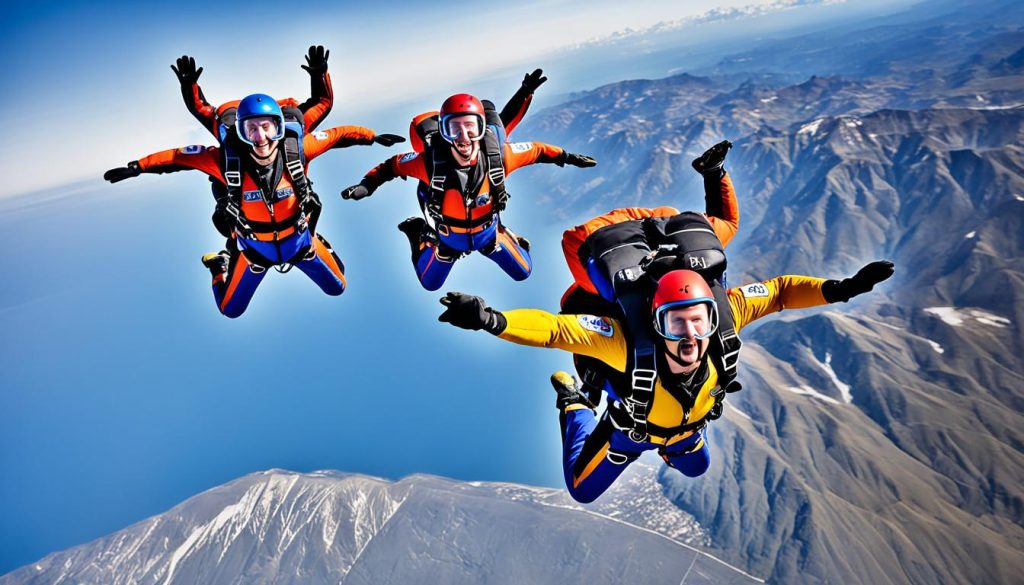
Gear and Equipment for HALO Jumps
HALO jumps require specialized gear and equipment to ensure the safety and success of the jump. While the basic gear, such as the rig, parachute, and helmet, remains consistent across all jumps, higher altitude jumps necessitate additional safety equipment. Let’s take a closer look at the gear and equipment required for HALO jumps:
Oxygen Equipment
One crucial piece of gear for high altitude jumps is the oxygen equipment. At intermediate altitudes, skydivers need to use supplemental oxygen from 8,000 feet until exit. This ensures that they have sufficient oxygen supply during the freefall and parachute deployment. For high altitude jumps, skydivers must breathe 100% pure oxygen prior to takeoff and maintain it throughout the entire ride to altitude.
| Altitude Classification | Oxygen Requirement |
|---|---|
| Intermediate Altitude | Supplemental oxygen from 8,000 feet until exit |
| High Altitude | Breathing 100% oxygen prior to takeoff and during the ride to altitude |
Altitude Classification
HALO jumps can be classified into different altitude categories based on the planned exit height. Each altitude classification comes with its own set of safety plans and requirements to ensure a successful jump. While the exact altitudes may vary depending on the mission or desired outcome, the following classifications are commonly used:
- Intermediate Altitude: Altitudes between 15,000 and 25,000 feet
- High Altitude: Altitudes between 25,000 and 35,000 feet
- Extreme Altitude: Altitudes above 35,000 feet
Pilots and oxygen monitors play a critical role in HALO jumps. They have additional responsibilities and must be equipped with the necessary gear to monitor the oxygen levels and ensure the safety of the skydivers throughout the jump.
When it comes to HALO jumps, having the right gear and equipment is essential for a successful and safe experience. From oxygen equipment to altitude classifications, understanding and utilizing the appropriate gear is crucial. So, gear up and get ready for an exhilarating high-altitude adventure!
Conclusion
High-altitude skydiving, including HALO and HAHO jumps, offers thrilling experiences for both military personnel and civilian skydivers. These jumps provide unique opportunities to push the boundaries of human capabilities and explore the exhilarating world of high-altitude freefall.
Engaging in high-altitude skydiving requires extensive training, adherence to strict safety measures, and the use of specialized equipment. It is crucial for participants to have a thorough understanding of the techniques and risks involved to ensure a safe and enjoyable experience.
HALO jumps are renowned for their longer freefall times and higher exit altitudes, allowing skydivers to fully savor the adrenaline rush and breathtaking views. On the other hand, HAHO jumps offer the excitement of covering extended travel distances, providing an extraordinary sense of adventure.
Whether undertaking high-altitude skydiving for military operations or personal thrills, it is an extraordinary adventure that demands courage, skill, and precision. With proper preparation and an appreciation for the unique challenges these jumps present, high-altitude skydiving promises unforgettable moments and memories that will last a lifetime.

